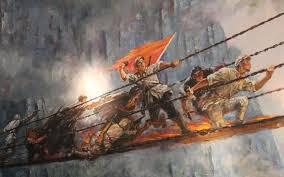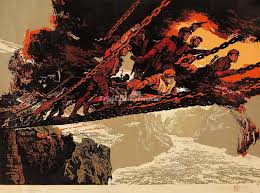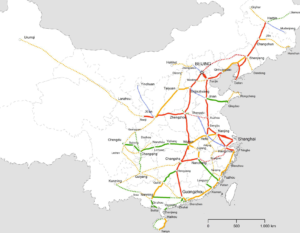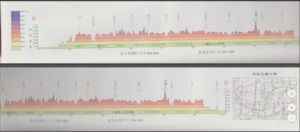a case study in the meanings of dependence
#2 of 2 blogs
ENGINEERING PRECIPITOUS KHAM
From Chengdu and the Sichuan basin the new railway climbs to the Tibetan Plateau from Chaksam (in Chinese Luding), at the crossing of the Dadu River at the foot of the high plateau. Chaksam in Tibetan means iron bridge, after the old forged iron chain link bridge, a technology mastered many centuries ago both in Tibet and China. In Tibet there are many chaksam. In Tibetan, a railway is a chaglam, literally iron path.
The chaglam entering Tibet at Chaksam recapitulates the entry of Chinese Communist Party troops into Tibet, escaping their KMT Nationalist pursuers in 1935 on the famous Long March. Once the PLA soldiers were across the bridge, an exploit endlessly mythologised in later revolutionary propaganda, they had escaped only to find themselves even more unwelcome among the Tibetans whose monasteries and food stores the PLA looted. It was not an auspicious start to CCP-Tibetan relations.
Once the PLA soldiers were across the bridge, an exploit endlessly mythologised in later revolutionary propaganda, they had escaped only to find themselves even more unwelcome among the Tibetans whose monasteries and food stores the PLA looted. It was not an auspicious start to CCP-Tibetan relations.
Decades of preparatory work have preceded the decision to proceed with this new transTibetan chaglam; as was the case a decade ago with the Lanzhou-Xining-Gormo-Lhasa line traversing Tibet’s northern alpine desert. That line required much scientific research, primarily because so much of the line is over permafrost, which proves to be anything but permanent when rail bed ballast, soaking up the heat of the sun, is laid across the high plateau, resulting in not only permafrost melt, but dangerous slumping as meltwater melts away, very dangerous for a fast moving train. In the case of the Nyingtri line, the problems are only intermittently the technical fixes needed to stabilise permafrost, and are more to do with the precipitous terrain.[1]
Kham is often, in Tibetan, poetically and accurately defined as “precipitous Kham.”  The massif of eastern Tibet thrust into lowland China by the collision of the Indian and Eurasian continents, is deeply dissected by the great rivers that rise in Tibet and water both China and Southeast Asia. The railway must traverse both the massif and the deep valleys cut by wild mountain rivers over millions of years, the gorges of the Yangtze, Mekong and the Salween of Myanmar.
The massif of eastern Tibet thrust into lowland China by the collision of the Indian and Eurasian continents, is deeply dissected by the great rivers that rise in Tibet and water both China and Southeast Asia. The railway must traverse both the massif and the deep valleys cut by wild mountain rivers over millions of years, the gorges of the Yangtze, Mekong and the Salween of Myanmar.
The new lines will have to cross two major tributaries of the Yangtze, the Dadu (Mu Chu in Tibetan) and Yalong (Nyak Chu in Tibetan) rivers, before crossing the main channel of the Yangtze (Dri Chu in Tibetan). The Yangtze is the actual boundary between Sichuan to the east and Tibet Autonomous Region to the west. The line then has to cross the Nu river, (Myanmar’s Salween, Gyalmo Ngulchu in Tibetan) and skirt major tributaries of the Yarlung Tsangpo (Brahmaputra). Between these many river crossings, the rail line has again and again to climb to the Tibetan Plateau floor, which varies between 4000 and 5000m. Only after reaching Nyingtri is there a naturally available manageable gradient, where the line can ascend the Nyang Chu, a tributary of the Yarlung Tsangpo, in those stretches where the banks can accommodate both a highway and a railway.
The mountain most sacred of all to Bonpo practitioners is near Nyingtri. Kongpo Bonri is a pilgrimage circuit (walked by all anti-clockwise) very much alive today, despite the close proximity of the 318 Highway. “What makes Bonri holy? In the thirteenth century a lama called Ripa Drugse visited the mountain. Seeing that he was a magus of the Bon religion, the indigenous spirits of the place attacked him, but his spiritual training prevailed, and he succeeded in subduing them. In his meditation on the forested slopes of the mountain the lama saw that he was merely completing a mission that had been initiated by the founder of the Bon religion, Tonpa Shenrab himself, thousands of years earlier.  Ripa Drugse recorded his exploits and visions in his writings, and “opened” Bonri as a pilgrimage place for adherents of his faith. Over the centuries other lamas followed him, writing down their own achievements and visions. The creation of Bonri as a holy mountain was thus a cumulative process, and all these accounts were later compiled, in the eighteenth century, in a neyig, a sacred “guidebook” to the area. These compilations are not merely descriptive, but prescriptive: they tell pilgrims what to do and how they should perceive the sites they visit.”[2]
Ripa Drugse recorded his exploits and visions in his writings, and “opened” Bonri as a pilgrimage place for adherents of his faith. Over the centuries other lamas followed him, writing down their own achievements and visions. The creation of Bonri as a holy mountain was thus a cumulative process, and all these accounts were later compiled, in the eighteenth century, in a neyig, a sacred “guidebook” to the area. These compilations are not merely descriptive, but prescriptive: they tell pilgrims what to do and how they should perceive the sites they visit.”[2]
Trains cannot handle steep gradients as well as trucks do on highways. The alternation of altitudes across Kham is a great challenge, requiring much tunnelling and bridging to even out the gradient, especially if the train is to manage the 1600 kms from Chengdu to Lhasa in 15 hours, including stops.
The speed of the trains will be enhanced by keeping stops to a minimum. On the 1776 kms of the new high-speed line to Urumqi in Xinjiang, there are only 31 stations, on average 57 kms apart, but actually clustered in populated areas with long stretches in between; and high-speed trains stop at only a few of those stations.
END OF THE LINE LHASA, IN THE ERA OF HIGH SPEED RAIL
The construction of the Chengdu to Lhasa line should not be seen in isolation; it is only one of many new lines, and only part of a huge debt-funded capital expenditure. In China, more attention is focused on the rapid expansion of high-speed rail, which is greatly shrinking the entire People’s Republic, enabling those who can afford it fast access to any lowland market. The expansion of high-speed rail, even if Tibet is not included, will also mean reaching Tibet from Shanghai or Beijing or Guangzhou will be much faster, even if it entails changing to a slower train at Lanzhou or Chengdu.
The RMB 3.8 trillion budget allocated for 13th Five-Year Plan rail projects, to 2020, should include finalising the grid of high-speed lines. In English, this is known as a series of four east-west lines, and a series of four north-south lines. In Chinese, this vision of intersecting rail lines is simply known as the vertical and horizontal lines, as if China’s geobody can be inscribed, just like the writing of a Chinese character, the ultimate in ensuring China is ultra-modern, yet with Chinese characteristics. The four vertical and four horizontal brush strokes were completed in 2015, leaving rail engineers free to move on.
The high-speed construction boom has been in the most densely populated provinces, until now. The high speed line across northern Tibet, linking Lanzhou to Urumqi, which began operation in 2014, promises to cover 1776 kms in as little as eight hours, and extends high-speed rail far to the west. But Xinjiang offers wealth accumulation opportunities quite unlike Tibet. Xinjiang these days is a major industrial hub, with oil, gas, coal-fired electricity generators enabling a shift of aluminium smelting westward, as well as Xinjiang’s position as China’s entry portal to the energy resources of Central Asia. Inner Mongolia likewise is a major source of wealth accumulation for China, with its rare earths, coal, oil, gas and steel mills. Two high-speed lines into Inner Mongolia are planned, due for completion by the end of this Five-Year Plan in 2020.[3]
While there is little economic justification for a new rail line into Tibet, and still less for a high-speed line, there are high-speed lines and other upgraded rail lines just below the Tibetan Plateau, which make Tibet more accessible. A high-speed (up to 250 kmh) line will soon link X’ian and Chengdu.[4] Other rail lines connecting China’s northwest with its southwest have also been built recently, but not for high speed. Some ascend the eastern edges of the Tibetan Plateau, some stay in the lowlands, but all bring Tibet closer.
”The Cheng-Lan railway, with a length of 457.59 km starts from Chengdu to get connected with Lan-Yu Railway (linking Lanzhou and Chongqing). This railway line together with the finished Bao- Cheng (Baoji-Chengdu) railway, the under-constructed Lan-Yu [Lanzhou to Chongqing] line will form a developed railway network connecting the northwest to southwest of China. The Cheng-Lan railway discussed in the paper will work as an important branch of the national traffic network. This railway starts at an elevation of about 500 m above sea level, runs northwards through the Longmenshan mountain, and climbs up to the east of the Tibetan Plateau at an elevation of 3,500 m. After that, it crosses watershed mountains between the Yangtze River and the Yellow River, and finally reaches Lanzhou City at an elevation of 1,500 m. The railway line passes through three fault zones, i.e., the Longmanshan, Minjiang, and Dongkunlun. Landslides induced by the 2008 Wenchuan earthquake make the above-mentioned geological environment even worse. The region where the railway stretches over is classified as active geological area with high georisk.”[5]
Despite the earthquake and landslide risks, these projects are going ahead. The availability of high speed rail is rapidly changing how Chinese travel. Although many Chinese complain that high speed rail is expensive, attracting only those who can afford it, there are plenty of rich and aspirant rich, and plenty of first tier and second tier cities across China that need personal visits from entrepreneurs. The latest high speed rolling stock features not only ultramodern design, but also carriages with few seats for the poor, and many beds for the rich. High speed, on long haul routes such as Lanzhou to Urumqi, Xinjiang in eight hours, is an overnight journey, comfortably asleep in luxury.
This new way to travel, competitive with flying, even over long distances, promises to be highly profitable for the train manufacturers, especially Bombardier. “China Railways Corporation (CRC) has awarded Bombardier Sifang Transportation (BST), a joint venture of Bombardier and CRRC’s CSR Sifang Rolling Stock, a Yuan 1.1bn ($US 169.8m) contract to supply five 16-car high-speed sleeper trains. The 250km/h stainless-steel bodied trains are specially designed for overnight services and are fitted with sleeping berths. Manufacture of the 430m-long trains will take place at BST’s production facility in Qingdao, China and the sets will be powered by Bombardier’s Mitrac propulsion system, supplied by Bombardier’s CPC Propulsion System subsidiary. A prototype of the train presented to CRC in July included 532 soft-class berths and 110 second-class seats. The prototype was intended to gauge reaction to the overnight concept which CRC hopes will help it make better use of the high-speed network for passengers who face long journeys due to the great distances between cities.” [6]
 The Chengdu to Lhasa rail line will similarly be highly profitable for Bombardier and its quarrelling Chinese partners, since Bombardier invented the pressurised train carriages used in Tibet to protect lowlanders from exposure to the thin air of Tibet until they step out onto the platform in Lhasa. Bombardier invented what it calls the Local Tibet car, and the Tibet tourist car which has Coach/Sleeper/Restaurant.[7] These designs will be available for the Chengdu to Lhasa line, and there is no competition, no other product designed for high altitudes.
The Chengdu to Lhasa rail line will similarly be highly profitable for Bombardier and its quarrelling Chinese partners, since Bombardier invented the pressurised train carriages used in Tibet to protect lowlanders from exposure to the thin air of Tibet until they step out onto the platform in Lhasa. Bombardier invented what it calls the Local Tibet car, and the Tibet tourist car which has Coach/Sleeper/Restaurant.[7] These designs will be available for the Chengdu to Lhasa line, and there is no competition, no other product designed for high altitudes.
The combination of widespread high speed throughout China’s lowlands, and the Bombardier Local Tibet pressurised car in the uplands will make Tibet much closer and more accessible. Currently, the train timetable allows 41 hours for trains departing Beijing to reach Lhasa, over 46 hours Shanghai to Lhasa and nearly 53 hours Guangzhou to Lhasa. [8] For passengers embarking in Shanghai or Guangzhou, the combination of high-speed and the Chengdu to Lhasa rail makes for a much shorter journey, avoiding a long northward detour. The result will be that the 46 hours from Shanghai to Lhasa should be reduced to only 25.[9] When the high-speed line from Guangzhou to Chengdu is completed, the current 53 hours will be halved.
These timings matter, not only to business people, but to tourists too, who have limited holiday time.
A RAILWAY FOR ENDING TIBETAN POVERTY?
Unlike the Urumqi line and the alpine desert lines across northern Tibet, the Chengdu to Lhasa line traverses some of the most densely populated Tibetan counties, and China will argue that the rationale for its construction is poverty alleviation. In the census of 2000, the total Tibetan population in the counties directly on this new rail line was 444,000, out of a total Tibetan population of over 5,000,000. By Chinese standards, this is not a big population but around one in twelve of all Tibetans will be directly impacted by this railway.
Around the world, it is a standard argument that enabling poor people to access distant, wealthy, urban markets is a way of alleviating poverty. This is a standard argument for railway construction across areas inhabited by the poor, and is routinely invoked by, for example, the World Bank. Similarly, China argued that poor Tibetans would be enriched by the trading opportunities opened by the 2006 rail line from Lanzhou and Xining to Lhasa; and no doubt will argue that the Chengdu to Lhasa line will benefit the poor.
In reality China has done almost nothing in the past 60 years to integrate the natural advantages of Tibet, in livestock production, dairy and wool, into the Chinese economy. It takes much more than a railway line to get Tibetan produce to Chinese markets. It also requires a commodity chain, investment in logistics and marketing, the construction of stock yards, cold chains, factories for processing and value adding, and a distribution system that returns value to producers, rather than monopolising the increase in price every time a commodity changes hands. Almost none of these preconditions exist in Tibet, or in the Chinese cities closest to Tibet, including Chengdu.
At much lower altitudes, the Asian Development Bank reluctantly rated the impact on poverty of the $800m spent on building the Dali to Lijiang railway as “significant.”[10] The Chengdu to Lhasa rail line is to traverse heartlands of Tibetan pastoral production, but without any plans for enabling pastoral producers to access markets, even though dairy products are now highly fashionable health foods sold at premium prices in China’s cities.
The rail line will largely follow the existing highway, which has been greatly upgraded in recent years, at great expense, yet without doing much to enable poor Tibetans effective access to China’s urban markets, consuming milk powder, ice cream and yoghurt imported from New Zealand instead. The poverty argument is propaganda, with no substance behind it.
ACTUAL BENEFICIARIES
If Tibetans are unlikely to benefit, who will? One certainty is that Bombardier is positioned to supply the rolling stock. Montreal-based Bombardier sold 361 pressurised carriages specifically designed for the thin air of Tibet, for the first rail line into Tibet, a proud moment.
Bombardier went on to invest heavily in China, with a joint venture factory to produce railcars. But Bombardier today is overstretched, in debt, close to collapse. Above all, it badly needs to make sales, and get cash flow through the door.
Bombardier remains in a delicate and vulnerable situation, brought on by a huge accumulation of debt in its aircraft manufacturing business, due to delays in creating a saleable aircraft, and making actual sales. The family owned company, built by the inventors of the Skidoo snowmobile, invested heavily in designing aircraft that could compete with giants Boeing and Airbus, only to have their fuel-efficient C Series arrive at a time when fuel costs are no longer of much concern to airlines. So deep is Bombardier’s debt, leaving it bereft of working capital, it urgently needed to raise fresh capital to stay in business, after reporting a massive loss due to writing off much of the costs of developing the new aircraft.
Bombardier in late 2015 considered selling its railcar manufacturing wing to its Chinese partners, even though the whole idea of the 50/50 joint venture was to not only give Bombardier the connections and inside track on getting Chinese orders, but also joining the Chinese in competing worldwide for orders. To lose its rail arm, headquartered in Germany, would be the loss of core assets. Bombardier’s unique business model of manufacturing both railway rolling stock and aeroplanes had long been able to balance the regular income of the rail sales with the much more volatile cash flow of aircraft. To lose the rail business, especially to its own Chinese partners, would be humiliating, and so alarmed the Quebec provincial government that it stepped in, arguing that it is normal that governments protect their aircraft manufacturers.
At the time of this crisis, China’s two big state-owned rail construction corporations were, at Beijing’s insistence, merging into one giant, and were preoccupied with how this shotgun wedding would be done. Perhaps it is only this accident of timing that enabled Bombardier to escape receiving a formal takeover offer from China.
Bombardier explored every possible source of fresh capital, including launching an IPO to bring money and new shareholders on board, even though the family owners insist on maintaining control, through giving themselves shares with 10 times the voting rights of other shareholders. The IPO fell through, as Bombardier’s shares slid over 70%, as news of the aircraft design and manufacture losses was revealed, leaving Bombardier with a reputation among investors of a chronic under-performer.
More generous in approach was the Quebec provincial government, which invested $1 billion in Bombardier, a protective, mercantilist investment for its Montreal-based hometown hero, followed swiftly by a major capital injection from Quebec’s public employee pension fund, which in return gets to appoint 30% of the Bombardier board. The pension fund, Caisse de dépôt et placement du Québec purchased 30 per cent of Bombardier’s rail division in November 2015 for C$2 billion.[11]
It looked, by early 2016, that Bombardier had recapitalised itself, and was on the verge, at last, of selling a substantial number of its new aircraft to Delta Airlines. The crisis, however, was not over. Bombardier has now had a falling-out with its Chinese partner, which bid against Bombardier for a contract to build trains for Chicago. China Sifang’s bid was not only cheaper than Bombardier’s. What clinched the deal was Sifang’s promise to build its factory on Chicago’s poor and black South Sid; while Bombardier already has a factory in upstate New York. Bombardier’s response to being outflanked by its own partner was outrage, calling the Chicago decision “rigged” and “Illegal.”[12]
Bombardier, having suffered the indignity of its Chinese tech transfer partners hoping to buy out their senior partner, is in a tense and unstable relationship with its train builder partners, and the train builders are all quarrelling with the train operators over who is to blame for China’s poor record of train smashes.
WHO GAINS MOST?
The greatest beneficiary, rather obviously, is China’s party-state. But, less obviously, the benefit of the vast expenditure needed to construct the Chengdu to Lhasa rail is not economic. There is no economic justification for this line, no business case to be made, no cost/benefit analysis showing any return on investment. It may well accelerate the tourism boom, as China’s mass domestic tourists find east coast China to Lhasa in 25 comfy train hours a unique selling proposition hard to resist, and they get to discover Bayi, and entirely Chinese city in southern Tibet, surrounded by “virgin forest”. While the party-state controls all major scenic sites, and controls their interpretation, mass tourism seldom returns substantial revenue to the state.
The other potential economic pay-off of a rail line across Kham is access to the biggest copper province of Tibet, around Jomda, between Derge and Chamdo, in a district usually called Yulong. Here the biggest deposits of copper, gold, silver and other valuable metals have been found, and carefully evaluated by teams of geologists over decades. However, these remain stranded assets unless they can connect with markets and initially with smelters that can convert the concentrates produced on site into separate, pure metals. The size and scale of the Yulong deposits, and their remoteness, and China’s acute reliance on imported copper and gold, all suggest the necessity for a rail line.
There are two highways linking Chengdu to Kham and central Tibet. The more northerly route, highway G317, passes close to the copper deposits. The planned railway takes the more southerly of these two routes, along highway G318, 200 kms south of the copper deposits, in terrain so rugged there is barely a dirt road connecting the two highways. The intrepid Gyurme Dorje, in his Tibet Handbook devotes pages to this remote area and its monasteries.[13]
There could be no greater evidence that there will be very little economic return on the capital invested to build the Chengdu to Lhasa line than the bypassing of the copper of Yulong. Yulong is just within Tibet Autonomous Region, on the west side of the Dri Chu (Yangtze), and thus potentially a contributor to the revenues of a government utterly reliant on subsidies from Beijing, so short is local revenue.
China’s party-state says development is the answer to all Tibetan problems, and that economic growth across China remains its top priority. Yet, in Tibet, it is dependence on Beijing that constantly grows, with no sign of effective economic take-off in central Tibet (TAR). As economist Andrew Fischer has shown in depth, the dependence only deepens, while plans to integrate the actual Tibetan pastoral livestock economy along the new rail line, into China’s economy, do not exist. Peking University sociology professor Ma Rong first characterised central Tibet as a dependent economy in 1993, and dependence has since only intensified.[14]
The pay-off, for the party-state, is dependence, control, inscribing the presence of the sovereign state across the land, and in the lives of the Tibetans. Sociologist Ma Rong has long argued that “the TAR has not been integrated into the ‘core’ economically. An entirely new economic and administrative formation was established; radically different from the old [Tibetan] regime. This new setup was imported from outside and did not emerge from the native soil. Nor was it an attempt to add new elements that could be grafted onto the old foundation.”[15]
The inscription of a railway, through Kandze, the most unhappy of all Tibetan prefectures, and on to Lhasa, could in theory reverse this trend, strengthen the rural Tibetan economy, add value to pastoral livestock production, and open up access to urban markets, much as Inner Mongolia has become a major base for dairy production distributed throughout China.[16] In reality, this railway, as with all major projects of the party-state in Tibet, is intended only to manifest the presence of the state on the land, and in the lives of the masses, while providing the world with images of sleek, modern trains speeding through the Tibetan countryside.
This chaglam, Tibetan for railway, literally iron path, could yet become a boost, lifting poor Tibetans out of remoteness and inability to access markets, if only Beijing would pay as much attention to the soft infrastructure of development: vocational training, micro-credit, agricultural extension, livestock insurance, logistics at a local and regional level. But Beijing remains fixated on hard infrastructure, on mega-projects, all of which establish state authority, where traditionally no state had authority. Such projects make local populations visible and legible to the security state.
IN THE LONGER TERM
If one looks at the official list of the 13th Five-Year Plan projects specifically targeting Tibet, one could argue that none, except for the railway, have much potential to become integral to the Tibetan economy, embedded in Tibet’s pastoral production landscapes. A rail line in Tibet, with Tibetan characteristics, could do much for Tibet, as the Tibetan artists featured in this blog, showed clearly in 2006, when invited to consider the arrival of the chaglam.


The five key projects of the 13th Plan that most directly impact Tibet are, in China’s priority order, the Sichuan-Tibet railway, new hydro power plants with an aggregate capacity of 60,000 mw, Big reservoirs in Tibet and other area, urbanization of 100 million people in central and west China, ecological restoration of Qinghai-Tibet Plateau and other ecologically important areas. What is remarkable is that none strengthen the Tibetan economy, in fact most are designed torequire removal, relocation and displacement of Tibetan communities, whether in the name of ecological restoration, poverty alleviation, dam or railway building. Far from keeping folks on their land, enhancing their productivity and access to markets, all of these big projects, with their big budgets, and big immigrant construction workforces, all further reduce Tibet to more extreme dependence, on the fringes of a modern economy superimposed onto Tibet.
This is not development, even though China justifies its interventions in the name of development. This is nation-building, the centuries-long process of turning an empire into a nation-state under a sovereign power that manifestly exercises power throughout all its territories, imposing its tangible presence in even the remotest lands that have not historically been administered by any distant central sovereign authority. This is the legacy of Qing dynasty conquest centuries ago, the unfinished agenda of proclaiming a unitary sovereign state, not with Tibetans as equal citizens, but despite them. “Sovereignty does not accrue naturally to a state”, as historians of China have pointed out.[17] Sovereignty is a performance, they remind us, within located and bounded territory, established only by imposing uniform biopower in all areas, so that territory and authority coincide. In Tibet, this remains China’s unfinished agenda.
This nation-building has been the pattern for decades. The new iron path into Tibet is not the only path governing Tibet; and the dependence of Tibet on Beijing subsidies is not the only form of dependence.
Central leaders in Beijing are in a pattern of path dependence, a polite social science term for addiction to repeating the same folly over and over, even when it consistently fails to get results. This is the fate of Tibet.
[1] HUANG Run-qiu, LI Yan-ron2, QU Ke and, WANG Ke, Engineering Geological Assessment for Route Selection of Railway Line in Geologically Active Area: A Case Study in China, Journal of Mountain Science, (2013) 10(4): 495–508
[2] Samten Karmay ed., Bon: the Magic Word: the Indigenous Religion of Tibet, Rubin Museum of Art, 2008, 137
[3] Keith Barrow, Go-ahead for high-speed lines to Inner Mongolia, International Railway Journal, January 06, 2016
[4] Kevin Smith, China steps up railway diplomacy in east Asia, International Railway Journal, February 03, 2016
[5] HUANG Run-qiu, LI Yan-ron2, QU Ke and, WANG Ke, Engineering Geological Assessment for Route Selection of Railway Line in Geologically Active Area: A Case Study in China, Journal of Mountain Science, (2013) 10(4): 495–508
[6] Kevin Smith, China orders more high-speed sleeper trains, International Railway Journal, December 18, 2015
[7] http://www.bombardier.com/en/media/newsList/details.1246-bombardier-awarded-a-contract-for-high-altitude-passenger-rail-cars-in-tibet.bombardiercom.html?
[8] http://www.chinatibettrain.com/fares.htm
[9] http://www.gochengdoo.com/en/blog/item/1718/10hour_chengdushanghai_train_opens_this_month_more_fast_trains_on_the_way
[10] Asian Development Bank, Validation Report, Dali–Lijiang Railway Project, January 2015, 8 http://www.adb.org/documents/people-s-republic-china-dali-lijiang-railway-project
[11] Ross Marowits, Chairman Beaudoin’s future clouds certification of CSeries; Two new deals for Bombardier rail division, Montreal Gazette, 19 December 2015
[12] Kristine Owram, Chicago Transit ‘rigged’ bidding process: Bombardier; Protest over Chinese firm’s vow to build plant on poverty-ridden south side, Montreal gazette 14 April 2016
Bertrand Marotte, Bombardier says Chicago ‘rigged’ rail contract, The Globe and Mail, 14 April 2016
[13] Gyurme Dorje, Tibet Handbook 4th edition, Footprint, 2009, 570-576
[14] Ma Rong, Economic Patterns, Migration and Ethnic Relationships in the Tibetan Autonomous Region, China, in Calvin Goldscheider ed., Population, Ethnicity and Nation-Building, Westview 1995
[15] Ma Rong, Population and Society in Contemporary Tibet, Hong Kong University Press, 2011, 180-183
[16] Julia A. Klein, Maria E. Fernandez-Gimenez, Han Wei et al., A Participatory Framework for Building
Resilient Social-Ecological Pastoral Systems, in: Restoring Community Connections to the Land: Building Resilience through Community-based Rangeland Management in China and Mongolia, CABI, 2012
[17] Douglas Howland and Luise White,The State of Sovereignty, Indiana University Press, 2009, 1-6




One reply on “CHINA’S FIVE-YEAR PLAN FOR A CHENGDU TO LHASA RAILWAY”
To whom it may concern:
I am currently researching a cultural history of the yak and would like to include these two images from this webpage as illustrations in the book. Could you please tell me who the artists are and where I might get permission to use these images or what the sources are?
I’d greatly appreciate your help with this project.
Best,
Michael Engelhard
(in Fairbanks, Alaska)